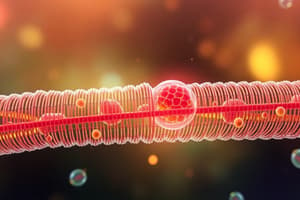Podcast
Questions and Answers
What effect does a larger concentration gradient have on the rate of transport?
What effect does a larger concentration gradient have on the rate of transport?
- It decreases the rate of transport.
- It only affects active transport.
- It increases the rate of transport. (correct)
- It has no effect on the rate of transport.
How does temperature affect the process of cell transport?
How does temperature affect the process of cell transport?
- Higher temperatures generally increase transport rates. (correct)
- Temperature only affects facilitated diffusion.
- Higher temperatures decrease transport rates.
- Temperature has no impact on transport rates.
Which factors can enhance the rate of transport processes across a membrane?
Which factors can enhance the rate of transport processes across a membrane?
- Presence of transport proteins. (correct)
- Increased membrane thickness.
- Smaller surface area.
- Lower concentration gradients.
What role does glucose transport primarily play in cells?
What role does glucose transport primarily play in cells?
Which transport mechanism is commonly used for the uptake of ions in nerve impulse transmission?
Which transport mechanism is commonly used for the uptake of ions in nerve impulse transmission?
What is the primary component of the cell membrane?
What is the primary component of the cell membrane?
Which type of transport requires energy from the cell?
Which type of transport requires energy from the cell?
How do cholesterol molecules affect the cell membrane?
How do cholesterol molecules affect the cell membrane?
What is the role of glycoproteins in the cell membrane?
What is the role of glycoproteins in the cell membrane?
Which factor does NOT affect the rate of diffusion?
Which factor does NOT affect the rate of diffusion?
What process involves the engulfing of large particles by the cell membrane?
What process involves the engulfing of large particles by the cell membrane?
What is the main purpose of the sodium-potassium pump?
What is the main purpose of the sodium-potassium pump?
What defines a selectively permeable membrane?
What defines a selectively permeable membrane?
Flashcards
Cell Membrane
Cell Membrane
A selectively permeable barrier that surrounds all cells, composed of phospholipids arranged in a bilayer, with embedded proteins and cholesterol.
Diffusion
Diffusion
The movement of molecules from an area of higher concentration to an area of lower concentration until equilibrium is reached.
Facilitated Diffusion
Facilitated Diffusion
A type of passive transport that uses transport proteins to help specific molecules move across the membrane down their concentration gradient.
Osmosis
Osmosis
Signup and view all the flashcards
Active Transport
Active Transport
Signup and view all the flashcards
Endocytosis
Endocytosis
Signup and view all the flashcards
Exocytosis
Exocytosis
Signup and view all the flashcards
Sodium-Potassium Pump
Sodium-Potassium Pump
Signup and view all the flashcards
Concentration Gradient
Concentration Gradient
Signup and view all the flashcards
Temperature & Transport
Temperature & Transport
Signup and view all the flashcards
Surface Area & Transport
Surface Area & Transport
Signup and view all the flashcards
Membrane Thickness & Transport
Membrane Thickness & Transport
Signup and view all the flashcards
Membrane Proteins & Transport
Membrane Proteins & Transport
Signup and view all the flashcards
Study Notes
Cell Membrane Structure
- The cell membrane, also known as the plasma membrane, is a selectively permeable barrier surrounding all cells.
- It's a fluid mosaic model, primarily composed of phospholipids arranged in a bilayer.
- Embedded within the phospholipid bilayer are various proteins: integral proteins spanning the membrane and peripheral proteins loosely bound.
- Cholesterol contributes to membrane fluidity and stability.
- Carbohydrates are attached to proteins (glycoproteins) and lipids (glycolipids), crucial for cell recognition and communication.
- Hydrophobic tails of phospholipids face each other, and hydrophilic heads face the aqueous environments inside and outside the cell.
Membrane Functions
- Regulates substance passage into and out of the cell.
- Provides a surface for biochemical reactions.
- Maintains cell shape and integrity.
- Enables cell-to-cell communication.
Types of Cell Transport
- Passive transport doesn't require cellular energy.
- Diffusion moves molecules from high to low concentration until equilibrium. Factors include concentration gradient, temperature, and molecule size.
- Facilitated diffusion uses transport proteins to aid specific molecule movement down their concentration gradient. Includes channel proteins (e.g., ion channels) and carrier proteins.
- Osmosis is water diffusion across a selectively permeable membrane, from high to low water concentration, crucial for maintaining cell volume and pressure.
- Active transport requires cellular energy, typically ATP.
- Sodium-potassium pump actively maintains sodium and potassium ion gradients across the membrane.
- Endocytosis brings material into the cell by membrane infolding. Includes phagocytosis (engulfing large particles) and pinocytosis (engulfing fluids).
- Exocytosis releases material from the cell via vesicle fusion with the membrane. Essential for protein and hormone secretion.
Factors Affecting Cell Transport
- Size of molecules affects diffusion rate; smaller molecules diffuse faster.
- Concentration gradient influences transport speed; larger gradients mean faster transport.
- Temperature generally increases transport rates.
- Surface area of the membrane increases transport rates (like diffusion).
- Membrane thickness affects diffusion speed; thinner membranes facilitate faster diffusion.
- Membrane proteins significantly enhance facilitated diffusion and active transport rates.
Importance of Cell Transport
- Nutrient uptake provides essential nutrients for energy and growth.
- Waste elimination removes waste products for homeostasis.
- Signal transduction allows cell communication via signaling molecules.
- Homeostasis maintenance results from appropriate component influx/efflux.
Specific Examples of Transport
- Glucose transport often uses facilitated diffusion via carrier proteins.
- Ion movement is crucial for nerve impulses and muscle contractions; often employs passive or active transport along ion gradients.
- Hormone secretion typically involves exocytosis.
- Immune response includes phagocytosis for pathogen and foreign material engulfment.
Studying That Suits You
Use AI to generate personalized quizzes and flashcards to suit your learning preferences.




